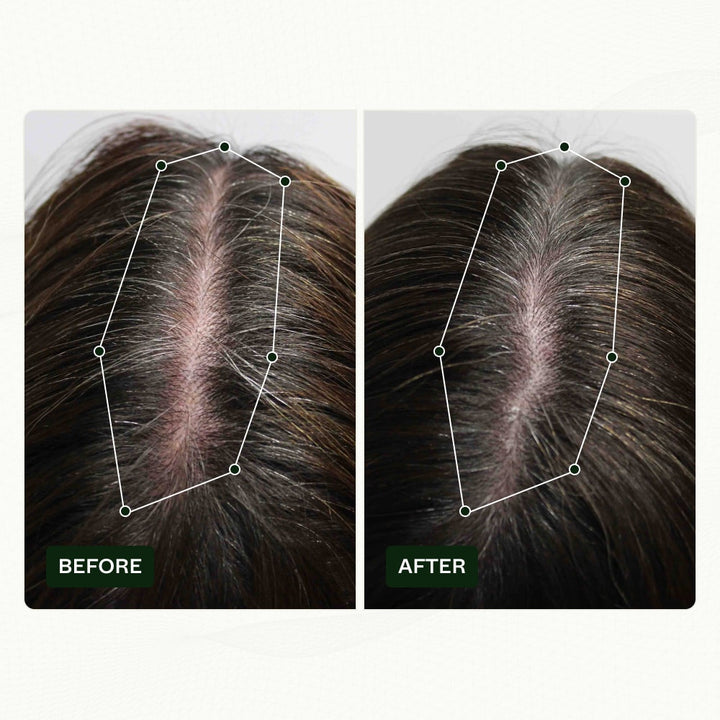Saw palmetto shampoo is becoming famous for its potential benefits for hair health, like reducing hair loss and promoting growth. But it's important to know that even natural products can have side effects.
In this easy-to-understand guide, we'll dive into what saw palmetto shampoo is, how it can help, and the side effects you might experience.
Whether you're thinking about trying it or just curious, we have all the information you need to make an informed decision. Stay tuned to learn all about the pros and cons of saw palmetto shampoo!
Table of content
What is saw palmetto?

Saw palmetto is a small palm tree native to the southeastern United States. Its berries are commonly used in supplements and herbal remedies due to their potential health benefits. These benefits include supporting prostate health, balancing hormone levels, and possibly promoting hair growth by reducing the conversion of testosterone into dihydrotestosterone (DHT), a hormone linked to hair loss.
Saw palmetto is available in various forms, including capsules, tablets, liquid extracts, and even as an ingredient in topical products like shampoos.
As your leading source for hair health information over the past 4 years, we never compromise on accuracy. When it comes to your health, you deserve information you can truly rely on - and earning your trust is our top priority.
Here's how Scandinavian Biolabs ensures every piece of content meets the highest standards of accuracy and integrity:
- Credentialed Experts: Our reviewers are actively practicing doctors and medical researchers
- Stringent Reviews: Content undergoes rigorous editing by subject specialists and review by a practicing doctor.
- Evidence-Based: We rely on well-established research from trusted scientific sources like peer-reviewed journals and health authorities.
- Full Transparency: Our editorial standards, writer credentials, reviewer credentials, correction process, and funding are all publicly documented.
- Independent Voice: While we do promote products, we operate in a vacuum to business operations. Our main goal is just an unwavering commitment to providing medically-sound guidance.
You can count on Scandinavian Biolabs to consistently deliver the trustworthy health information you deserve. Read our Editorial Standards.
What are the side effects of saw palmetto shampoo?
The side effects of saw palmetto shampoo are generally mild and may include skin irritation, such as itching or redness, especially in individuals with sensitive skin. Rarely some people might experience allergic reactions.
Expanding on this, saw palmetto is considered safe when used topically in shampoos. However, because it can have biological effects, namely its role in blocking the conversion of testosterone to DHT, its use can sometimes lead to unintended consequences on the scalp and skin.
These reactions are typically less severe than those associated with oral consumption of saw palmetto, including headache, dizziness, nausea, and changes in libido. It's essential to patch-test any new shampoo on a small area of skin before using it widely, particularly if you have a history of skin sensitivities or allergies.
Additionally, while saw palmetto shampoo generally aims to improve hair health, effectiveness, and experiences can vary widely among individuals.
According to the National Center for Complementary and Integrative Health (NCCIH), current research indicates no interactions between saw palmetto and medications.
Nonetheless, it's wise for individuals to consult with their healthcare provider before starting Saw Palmetto to see if there are updates regarding its interactions.
For men using saw palmetto, its impact on prostate-specific antigen (PSA) levels is a significant consideration. Saw palmetto may reduce PSA levels by up to 50% after 6 to 12 months of use. PSA levels are a critical marker used in screening for prostate cancer, meaning saw palmetto could potentially affect the accuracy of these tests.
What are the benefits of using saw palmetto shampoo?
Saw palmetto shampoo is celebrated for its natural approach to improving hair health by targeting hair loss and encouraging growth. Here are some key benefits:
- Promotes hair growth: May help stimulate hair follicles, promoting fuller and thicker hair.
- Reduces hair loss: Blocking the conversion of testosterone to DHT can slow down hair thinning and loss.
- Balances scalp health: Its anti-inflammatory properties can soothe the scalp, reducing dandruff and itchiness.
- Strengthens hair: This can improve hair strength, reducing breakage and leading to healthier-looking hair.
Does saw palmetto shampoo help with hair loss?
Yes, saw palmetto shampoo may help with hair loss. It works by blocking the enzyme that converts testosterone into dihydrotestosterone (DHT), a hormone associated with hair loss. This can slow down hair thinning and promote hair regrowth.
Saw palmetto is gaining attention for its potential to combat hair loss naturally. When used in shampoo form, these benefits are applied directly to the scalp, where it can work to prevent the hormonal action responsible for hair thinning.
While evidence is still emerging, many users report positive effects, including reduced hair fall and improved hair density. However, results can vary, and it's essential to combine saw palmetto shampoo with a healthy lifestyle and proper hair care routine for the best outcomes.
Does saw palmetto shampoo help grow hair?
Yes, saw palmetto shampoo can help with hair growth. Its active components are believed to inhibit the enzyme 5-alpha-reductase, which converts testosterone into dihydrotestosterone (DHT), a hormone associated with hair loss.
By reducing DHT levels, saw palmetto shampoo may prevent hair thinning and promote healthier, thicker hair growth.
Saw palmetto's effectiveness in hair care products like shampoos stems from its natural properties that target the hormonal aspect of hair loss. While it's not a guaranteed solution for everyone, many users report positive outcomes, including reduced hair fall and improved hair density.
Additionally, saw palmetto is often combined with other hair-nourishing ingredients in shampoos, enhancing scalp health and vitality.
However, results can vary based on individual factors such as genetics, underlying health conditions, and consistency of use. For the best outcome, using saw palmetto shampoo regularly is recommended as part of a comprehensive hair care routine.
How to use saw palmetto shampoo?
Using saw palmetto shampoo is a straightforward way to incorporate the potential hair loss prevention and growth benefits of saw palmetto into your daily routine.
Here's a step-by-step guide to get the most out of it:
- Wet your hair: Begin with thoroughly wet hair to ensure the shampoo can be evenly distributed.
- Apply the shampoo: Squeeze out a sufficient amount of saw palmetto shampoo, about the size of a quarter, and apply it to your scalp and hair.
- Massage gently: Use your fingertips to massage the shampoo into your scalp with circular motions. This helps to stimulate blood flow, promoting hair growth, and ensures the saw palmetto reaches your hair follicles.
- Leave it on: Allow the shampoo to sit on your scalp for 2-3 minutes, giving the active ingredients time to penetrate and work effectively.
- Rinse thoroughly: Rinse your hair completely, ensuring all shampoo is washed out to prevent any residue that could weigh down your hair or irritate your scalp.
- Repeat if necessary: For those with very oily hair or those who use styling products, a second application may be beneficial to thoroughly cleanse the scalp and hair.
- Follow with conditioner: Use a conditioner that complements the saw palmetto shampoo to keep your hair hydrated and manageable.
A better approach for your overall hair health

The Bio-Pilixin® Serum by Scandinavian Biolabs is meticulously formulated to help combat hair thinning and foster hair regrowth.
Utilizing cutting-edge stem cell technology, it leverages various plant growth factors to rejuvenate hair follicles and enhance hair proliferation.
The serum boosts scalp circulation and ensures the scalp and hair receive vital nutrients. Clinically proven for its efficacy, users have observed noticeable improvements within 45 days of regular use.
Designed for everyday application, this drug-free formula has garnered positive feedback from 93% of users in clinical trials, appreciating its effectiveness. Its composition is rigorously tested by independent labs, ensuring top-notch quality.
The serum's ingredients are entirely vegan, focusing on naturally sourced or bio-mimetic components for safety and environmental sustainability.
Key ingredients include Capilia Longa®, which has demonstrated a significant decrease in hair loss (up to 89%) and an increase in hair density (up to 52%) in specific studies. Niacinamide plays a crucial role in bolstering hair strength by promoting keratin synthesis.
Additionally, Vanillyl Butyl Ether introduces a gentle warming effect, causing a tingling sensation that enhances blood circulation and the transport of nutrients to the scalp.
Conclusion
Saw palmetto is a natural remedy popular for its potential to improve hair health, notably by reducing hair loss and promoting growth through its action on DHT levels.
While generally safe, it's essential to consult a healthcare provider before use, especially for those with health conditions or undergoing screenings.
Saw palmetto shampoos offer an accessible way to harness these benefits, potentially improving hair density and scalp health with regular use.
However, individual results can vary, and integrating such products into a consistent hair care routine is advisable for the best outcomes.
FAQs
Can saw palmetto shampoo prevent hair loss?
It can help reduce hair loss by blocking DHT, a hormone linked to hair thinning.
Are there any side effects to using saw palmetto shampoo?
While rare, some may experience mild scalp irritation or allergic reactions.
How often should I use saw palmetto shampoo for best results?
Regular use is recommended as directed on the product label or by a healthcare professional.
Can women use saw palmetto shampoo?
Yes, it suits both men and women looking to improve hair health.
Does saw palmetto interact with medications?
Current research does not indicate significant interactions, but consultation with a healthcare provider is advised.
References:
- https://nccih.nih.gov/health/palmetto/ataglance.htm#safety
- https://nccih.nih.gov/health/palmetto/ataglance.htm
- https://www.ncbi.nlm.nih.gov/pmc/articles/PMC2840915/
- https://www.ncbi.nlm.nih.gov/books/NBK547751/
- https://pubmed.ncbi.nlm.nih.gov/28879195/
- https://health.clevelandclinic.org/is-biotin-as-good-as-advertised-for-your-hair-loss/
- https://www.aad.org/dw/dw-insights-and-inquiries/archive/2021/biotin-supplementation-hair-nails
- https://www.medicalnewstoday.com/articles/319427
- https://www.ncbi.nlm.nih.gov/pmc/articles/PMC5582478/
Read more:







